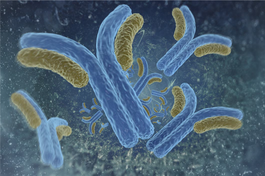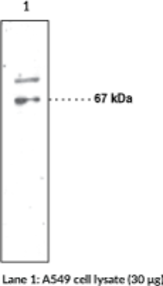Cayman
Showing 8851–9000 of 45550 results
-
Agnuside is an iridoid glycoside originally isolated from V. rotundifolia fruit that has diverse biological activities.{42077,42078,42079,42080} It inhibits COX-2 with an IC50 value of 0.026 mg/ml but exhibits less than 10% inhibition of COX-1 at this concentration.{42077} It also inhibits 46.3, 66.8, and 82.1% of P-glycoprotein (P-gp) ATPase activity at concentrations of 5, 25, and 100 μM, respectively.{25373} Agnuside (0.1-10 μM) induces proliferation of MCF-7 breast cancer cells, an effect that is inhibited by the estrogen receptor antagonist fulvestrant (ICI 182780; Item No. 10011269).{42078} In vivo, agnuside (50 mg/kg) reduces acetic acid-induced writhing in mice indicating analgesia.{42079} It also suppresses production of the pro-inflammatory mediators prostaglandin E2 (PGE2) and leukotriene B4 (LTB4; Item No. 20110) and the T cell-mediated cytokines IL-2, TNF-α, INF-γ, IL-4, IL-10, and IL-17 in splenocytes and arthritic paw tissue from arthritic adrenalectomized rats.{42080}
Brand:CaymanSKU:24971 - 5 mgAvailable on backorder
Agomelatine is an agonist of melatonin (MT) receptors and a derivative of melatonin (Item No. 14427).{53599} It binds to MT1 and MT2 receptors (Kis = 0.14 and 0.41 nM, respectively) and has an EC50 value of 0.1 nM in a [35S]GTPγS binding assay using CHO cells expressing MT2 receptors. Agomelatine is also an antagonist of the serotonin (5-HT) receptor subtypes 5-HT2B and 5-HT2C (Kis = 0.26 and 0.71 nM, respectively, for the human receptors).{16799} Agomelatine (40 mg/kg) inhibits the penile erection response induced by the 5-HT2 agonist Ro 60-0175 (Item No. 29500) in rats. It also increases extracellular levels of noradrenaline and dopamine in the frontal cortex of freely moving rats when administered at doses ranging from 20 to 80 mg/kg. Agomelatine (10 mg/kg) reduces immobility time in the forced swim test and increases the amount of time spent in the open arms of the elevated plus maze in mice, indicating antidepressant-like and anxiolytic-like activity, in a transgenic neuroendocrine model of depression.{53600} It also increases the rate of readjustment to circadian activity cycles following an induced phase shift.
Brand:CaymanSKU:-Agomelatine is an agonist of melatonin (MT) receptors and a derivative of melatonin (Item No. 14427).{53599} It binds to MT1 and MT2 receptors (Kis = 0.14 and 0.41 nM, respectively) and has an EC50 value of 0.1 nM in a [35S]GTPγS binding assay using CHO cells expressing MT2 receptors. Agomelatine is also an antagonist of the serotonin (5-HT) receptor subtypes 5-HT2B and 5-HT2C (Kis = 0.26 and 0.71 nM, respectively, for the human receptors).{16799} Agomelatine (40 mg/kg) inhibits the penile erection response induced by the 5-HT2 agonist Ro 60-0175 (Item No. 29500) in rats. It also increases extracellular levels of noradrenaline and dopamine in the frontal cortex of freely moving rats when administered at doses ranging from 20 to 80 mg/kg. Agomelatine (10 mg/kg) reduces immobility time in the forced swim test and increases the amount of time spent in the open arms of the elevated plus maze in mice, indicating antidepressant-like and anxiolytic-like activity, in a transgenic neuroendocrine model of depression.{53600} It also increases the rate of readjustment to circadian activity cycles following an induced phase shift.
Brand:CaymanSKU:-Agomelatine is an agonist of melatonin (MT) receptors and a derivative of melatonin (Item No. 14427).{53599} It binds to MT1 and MT2 receptors (Kis = 0.14 and 0.41 nM, respectively) and has an EC50 value of 0.1 nM in a [35S]GTPγS binding assay using CHO cells expressing MT2 receptors. Agomelatine is also an antagonist of the serotonin (5-HT) receptor subtypes 5-HT2B and 5-HT2C (Kis = 0.26 and 0.71 nM, respectively, for the human receptors).{16799} Agomelatine (40 mg/kg) inhibits the penile erection response induced by the 5-HT2 agonist Ro 60-0175 (Item No. 29500) in rats. It also increases extracellular levels of noradrenaline and dopamine in the frontal cortex of freely moving rats when administered at doses ranging from 20 to 80 mg/kg. Agomelatine (10 mg/kg) reduces immobility time in the forced swim test and increases the amount of time spent in the open arms of the elevated plus maze in mice, indicating antidepressant-like and anxiolytic-like activity, in a transgenic neuroendocrine model of depression.{53600} It also increases the rate of readjustment to circadian activity cycles following an induced phase shift.
Brand:CaymanSKU:-Agomelatine is an agonist of melatonin (MT) receptors and a derivative of melatonin (Item No. 14427).{53599} It binds to MT1 and MT2 receptors (Kis = 0.14 and 0.41 nM, respectively) and has an EC50 value of 0.1 nM in a [35S]GTPγS binding assay using CHO cells expressing MT2 receptors. Agomelatine is also an antagonist of the serotonin (5-HT) receptor subtypes 5-HT2B and 5-HT2C (Kis = 0.26 and 0.71 nM, respectively, for the human receptors).{16799} Agomelatine (40 mg/kg) inhibits the penile erection response induced by the 5-HT2 agonist Ro 60-0175 (Item No. 29500) in rats. It also increases extracellular levels of noradrenaline and dopamine in the frontal cortex of freely moving rats when administered at doses ranging from 20 to 80 mg/kg. Agomelatine (10 mg/kg) reduces immobility time in the forced swim test and increases the amount of time spent in the open arms of the elevated plus maze in mice, indicating antidepressant-like and anxiolytic-like activity, in a transgenic neuroendocrine model of depression.{53600} It also increases the rate of readjustment to circadian activity cycles following an induced phase shift.
Brand:CaymanSKU:-Agomelatine-d6 is intended for use as an internal standard for the quantification of agomelatine (Item No. 13203) by GC- or LC-MS. Agomelatine is an agonist of melatonin (MT) receptors and a derivative of melatonin (Item No. 14427).{53599} It binds to MT1 and MT2 receptors (Kis = 0.14 and 0.41 nM, respectively) and has an EC50 value of 0.1 nM in a [35S]GTPγS binding assay using CHO cells expressing MT2 receptors. Agomelatine is also an antagonist of the serotonin (5-HT) receptor subtypes 5-HT2B and 5-HT2C (Kis = 0.26 and 0.71 nM, respectively, for the human receptors).{16799} Agomelatine (40 mg/kg) inhibits the penile erection response induced by the 5-HT2 agonist Ro 60-0175 (Item No. 29520) in rats. It also increases extracellular levels of noradrenaline and dopamine in the frontal cortex of freely moving rats when administered at doses ranging from 20 to 80 mg/kg. Agomelatine (10 mg/kg) reduces immobility time in the forced swim test and increases the amount of time spent in the open arms of the elevated plus maze, indicating antidepressant-like and anxiolytic-like activity, in a transgenic neuroendocrine model of depression.{53600} It also increases the rate of readjustment to circadian activity cycles following an induced phase shift.
Brand:CaymanSKU:26447 - 1 mgAvailable on backorder
Thromboxane (TXA2) activates the T prostanoid (TP) receptor. Prostaglandin E2 (PGE2) activates four E prostanoid (EP) receptors, EP1-4. AH-23848 is a dual antagonist of TP{3339} and EP4 receptors.{1755} It originally was found to inhibit TXA2-induced platelet aggregation (IC50 = 0.26 μM){3339} and the contraction of human bronchial smooth muscle induced by the TP agonist U-46619.{1756} AH-23848 was subsequently demonstrated to impair PGE2-mediated relaxation of piglet saphenous vein by antagonizing the PGE2 receptor EP4.{1755} By inhibiting EP4, it likewise suppresses serum-induced cAMP generation, cyclin A synthesis, and the proliferation of fibroblasts{16771}, as well as reduces metastasis in a mouse model of metastatic breast cancer.{14694}
Brand:CaymanSKU:-Available on backorder
Thromboxane (TXA2) activates the T prostanoid (TP) receptor. Prostaglandin E2 (PGE2) activates four E prostanoid (EP) receptors, EP1-4. AH-23848 is a dual antagonist of TP{3339} and EP4 receptors.{1755} It originally was found to inhibit TXA2-induced platelet aggregation (IC50 = 0.26 μM){3339} and the contraction of human bronchial smooth muscle induced by the TP agonist U-46619.{1756} AH-23848 was subsequently demonstrated to impair PGE2-mediated relaxation of piglet saphenous vein by antagonizing the PGE2 receptor EP4.{1755} By inhibiting EP4, it likewise suppresses serum-induced cAMP generation, cyclin A synthesis, and the proliferation of fibroblasts{16771}, as well as reduces metastasis in a mouse model of metastatic breast cancer.{14694}
Brand:CaymanSKU:-Available on backorder
Thromboxane (TXA2) activates the T prostanoid (TP) receptor. Prostaglandin E2 (PGE2) activates four E prostanoid (EP) receptors, EP1-4. AH-23848 is a dual antagonist of TP{3339} and EP4 receptors.{1755} It originally was found to inhibit TXA2-induced platelet aggregation (IC50 = 0.26 μM){3339} and the contraction of human bronchial smooth muscle induced by the TP agonist U-46619.{1756} AH-23848 was subsequently demonstrated to impair PGE2-mediated relaxation of piglet saphenous vein by antagonizing the PGE2 receptor EP4.{1755} By inhibiting EP4, it likewise suppresses serum-induced cAMP generation, cyclin A synthesis, and the proliferation of fibroblasts{16771}, as well as reduces metastasis in a mouse model of metastatic breast cancer.{14694}
Brand:CaymanSKU:-Available on backorder
Thromboxane (TXA2) activates the T prostanoid (TP) receptor. Prostaglandin E2 (PGE2) activates four E prostanoid (EP) receptors, EP1-4. AH-23848 is a dual antagonist of TP{3339} and EP4 receptors.{1755} It originally was found to inhibit TXA2-induced platelet aggregation (IC50 = 0.26 μM){3339} and the contraction of human bronchial smooth muscle induced by the TP agonist U-46619.{1756} AH-23848 was subsequently demonstrated to impair PGE2-mediated relaxation of piglet saphenous vein by antagonizing the PGE2 receptor EP4.{1755} By inhibiting EP4, it likewise suppresses serum-induced cAMP generation, cyclin A synthesis, and the proliferation of fibroblasts{16771}, as well as reduces metastasis in a mouse model of metastatic breast cancer.{14694}
Brand:CaymanSKU:-Available on backorder
AH 6809 is an EP and DP receptor antagonist with nearly equal affinity for the cloned human EP1, EP2, EP3-III, and DP1 receptors.{8322} AH 6809 blocks the PGE2-induced accumulation of cAMP in COS cells transfected with the human EP2 receptor.{3391} It also blocks the accumulation of Ca2+ in Xenopus oocytes expressing the human EP1 receptor.{3176} In the human and guinea pig, the activity profile of AH 6809 is similar to that of SC-19220, but it is somewhat more potent.{3409} In the mouse, AH 6809 has the highest affinity for the EP2 receptor, but also acts as a weak ligand at the murine EP1 and DP1 receptors.{6640} In whole human platelets, AH 6809 is an effective antagonist of the antiaggregatory actions of PGD2, but not PGI2, with an EC50 of about 5 x 10−5 M.{3319}
Brand:CaymanSKU:-AH 6809 is an EP and DP receptor antagonist with nearly equal affinity for the cloned human EP1, EP2, EP3-III, and DP1 receptors.{8322} AH 6809 blocks the PGE2-induced accumulation of cAMP in COS cells transfected with the human EP2 receptor.{3391} It also blocks the accumulation of Ca2+ in Xenopus oocytes expressing the human EP1 receptor.{3176} In the human and guinea pig, the activity profile of AH 6809 is similar to that of SC-19220, but it is somewhat more potent.{3409} In the mouse, AH 6809 has the highest affinity for the EP2 receptor, but also acts as a weak ligand at the murine EP1 and DP1 receptors.{6640} In whole human platelets, AH 6809 is an effective antagonist of the antiaggregatory actions of PGD2, but not PGI2, with an EC50 of about 5 x 10−5 M.{3319}
Brand:CaymanSKU:-AH 6809 is an EP and DP receptor antagonist with nearly equal affinity for the cloned human EP1, EP2, EP3-III, and DP1 receptors.{8322} AH 6809 blocks the PGE2-induced accumulation of cAMP in COS cells transfected with the human EP2 receptor.{3391} It also blocks the accumulation of Ca2+ in Xenopus oocytes expressing the human EP1 receptor.{3176} In the human and guinea pig, the activity profile of AH 6809 is similar to that of SC-19220, but it is somewhat more potent.{3409} In the mouse, AH 6809 has the highest affinity for the EP2 receptor, but also acts as a weak ligand at the murine EP1 and DP1 receptors.{6640} In whole human platelets, AH 6809 is an effective antagonist of the antiaggregatory actions of PGD2, but not PGI2, with an EC50 of about 5 x 10−5 M.{3319}
Brand:CaymanSKU:-AH 6809 is an EP and DP receptor antagonist with nearly equal affinity for the cloned human EP1, EP2, EP3-III, and DP1 receptors.{8322} AH 6809 blocks the PGE2-induced accumulation of cAMP in COS cells transfected with the human EP2 receptor.{3391} It also blocks the accumulation of Ca2+ in Xenopus oocytes expressing the human EP1 receptor.{3176} In the human and guinea pig, the activity profile of AH 6809 is similar to that of SC-19220, but it is somewhat more potent.{3409} In the mouse, AH 6809 has the highest affinity for the EP2 receptor, but also acts as a weak ligand at the murine EP1 and DP1 receptors.{6640} In whole human platelets, AH 6809 is an effective antagonist of the antiaggregatory actions of PGD2, but not PGI2, with an EC50 of about 5 x 10−5 M.{3319}
Brand:CaymanSKU:-AH 7563 (Item No. 19335) is an analytical reference standard that is structurally categorized as an opioid. The physiological and toxicological properties of this compound are not known. This product is intended for research and forensic applications.
Brand:CaymanSKU:-Available on backorder
AH 7563 (Item No. 19335) is an analytical reference standard that is structurally categorized as an opioid. The physiological and toxicological properties of this compound are not known. This product is intended for research and forensic applications.
Brand:CaymanSKU:-Available on backorder
AH 7959 (Item No. 19366) is an analytical reference standard that is structurally categorized as an opioid. Unlike the related compound AH 7921 (Item Nos. 12036 | 19732), AH 7959 is ineffective as an analgesic in mice, by either the phenylquinone or hot plate test (ED50s > 100 mg/kg for both tests).{21531} This product is intended for research and forensic applications.
Brand:CaymanSKU:-Available on backorder
AH 7959 (Item No. 19366) is an analytical reference standard that is structurally categorized as an opioid. Unlike the related compound AH 7921 (Item Nos. 12036 | 19732), AH 7959 is ineffective as an analgesic in mice, by either the phenylquinone or hot plate test (ED50s > 100 mg/kg for both tests).{21531} This product is intended for research and forensic applications.
Brand:CaymanSKU:-Available on backorder
AH 8507 (Item No. 19367) is an analytical reference standard that is structurally categorized as an opioid. Unlike the related compound AH 7921 (Item Nos. 19732 | 12036), AH 8507 is ineffective as an analgesic in mice, by either the phenylquinone or hot plate test (ED50s > 100 mg/kg for both tests).{21531} This product is intended for research and forensic applications.
Brand:CaymanSKU:-Available on backorder
AH 8507 (Item No. 19367) is an analytical reference standard that is structurally categorized as an opioid. Unlike the related compound AH 7921 (Item Nos. 19732 | 12036), AH 8507 is ineffective as an analgesic in mice, by either the phenylquinone or hot plate test (ED50s > 100 mg/kg for both tests).{21531} This product is intended for research and forensic applications.
Brand:CaymanSKU:-Available on backorder
AH 8529 (Item No. 19368) is an analytical reference standard that is structurally categorized as an opioid. The physiological and toxicological properties of this compound are not known. This product is intended for research and forensic applications.
Brand:CaymanSKU:-Available on backorder
AH 8529 (Item No. 19368) is an analytical reference standard that is structurally categorized as an opioid. The physiological and toxicological properties of this compound are not known. This product is intended for research and forensic applications.
Brand:CaymanSKU:-Available on backorder
AH 8532 (Item No. 19338) is an analytical reference standard that is structurally categorized as an opioid. It markedly inhibits pain in mice induced by phenylquinone or heat (ED50s = 16 and 9.5 mg/kg, respectively).{21531} This product is intended for research and forensic applications.
Brand:CaymanSKU:-Available on backorder
AH 8532 (Item No. 19338) is an analytical reference standard that is structurally categorized as an opioid. It markedly inhibits pain in mice induced by phenylquinone or heat (ED50s = 16 and 9.5 mg/kg, respectively).{21531} This product is intended for research and forensic applications.
Brand:CaymanSKU:-Available on backorder
AH 8533 (Item No. 19336) is an analytical reference standard that is structurally categorized as an opioid. The physiological and toxicological properties of this compound are not known. This product is intended for research and forensic applications.
Brand:CaymanSKU:-Available on backorder
AH 8533 (Item No. 19336) is an analytical reference standard that is structurally categorized as an opioid. The physiological and toxicological properties of this compound are not known. This product is intended for research and forensic applications.
Brand:CaymanSKU:-Available on backorder
AHU377 is a methyl ester prodrug from of the neprilysin inhibitor LBQ657 (Item No. 19829).{42277} It increases plasma levels of atrial natriuretic factor (ANF) in conscious rats and anesthetized dogs when administered at doses of 10 and 30 mg/kg, respectively. AHU377 (30 mg/kg) increases ANF-induced urinary sodium excretion in anesthetized rats. Formulations containing AHU377 in combination with valsartan have been used for the treatment of mild to moderate hypertension and chronic heart failure.
Brand:CaymanSKU:21473 -Out of stock
AHU377 is a methyl ester prodrug from of the neprilysin inhibitor LBQ657 (Item No. 19829).{42277} It increases plasma levels of atrial natriuretic factor (ANF) in conscious rats and anesthetized dogs when administered at doses of 10 and 30 mg/kg, respectively. AHU377 (30 mg/kg) increases ANF-induced urinary sodium excretion in anesthetized rats. Formulations containing AHU377 in combination with valsartan have been used for the treatment of mild to moderate hypertension and chronic heart failure.
Brand:CaymanSKU:21473 -Out of stock
AHU377 is a methyl ester prodrug from of the neprilysin inhibitor LBQ657 (Item No. 19829).{42277} It increases plasma levels of atrial natriuretic factor (ANF) in conscious rats and anesthetized dogs when administered at doses of 10 and 30 mg/kg, respectively. AHU377 (30 mg/kg) increases ANF-induced urinary sodium excretion in anesthetized rats. Formulations containing AHU377 in combination with valsartan have been used for the treatment of mild to moderate hypertension and chronic heart failure.
Brand:CaymanSKU:21473 -Out of stock
AHU377 is a methyl ester prodrug from of the neprilysin inhibitor LBQ657 (Item No. 19829).{42277} It increases plasma levels of atrial natriuretic factor (ANF) in conscious rats and anesthetized dogs when administered at doses of 10 and 30 mg/kg, respectively. AHU377 (30 mg/kg) increases ANF-induced urinary sodium excretion in anesthetized rats. Formulations containing AHU377 in combination with valsartan have been used for the treatment of mild to moderate hypertension and chronic heart failure.
Brand:CaymanSKU:21473 -Out of stock
AHU377-d4 is intended for use as an internal standard for the quantification of AHU377 (Item No. 21473) by GC- or LC-MS. AHU377 is a methyl ester prodrug form of the neprilysin inhibitor LBQ657 (Item No. 19829).{42277} It increases plasma levels of atrial natriuretic factor (ANF) in conscious rats and anesthetized dogs when administered at doses of 10 and 30 mg/kg, respectively. AHU377 (30 mg/kg) increases ANF-induced urinary sodium excretion in anesthetized rats. Formulations containing AHU377 in combination with valsartan have been used in the treatment of mild to moderate hypertension and chronic heart failure.
Brand:CaymanSKU:25264 - 1 mgAvailable on backorder
AHU377-d4 is intended for use as an internal standard for the quantification of AHU377 (Item No. 21473) by GC- or LC-MS. AHU377 is a methyl ester prodrug form of the neprilysin inhibitor LBQ657 (Item No. 19829).{42277} It increases plasma levels of atrial natriuretic factor (ANF) in conscious rats and anesthetized dogs when administered at doses of 10 and 30 mg/kg, respectively. AHU377 (30 mg/kg) increases ANF-induced urinary sodium excretion in anesthetized rats. Formulations containing AHU377 in combination with valsartan have been used in the treatment of mild to moderate hypertension and chronic heart failure.
Brand:CaymanSKU:25264 - 5 mgAvailable on backorder
AHU377-d4 is intended for use as an internal standard for the quantification of AHU377 (Item No. 21473) by GC- or LC-MS. AHU377 is a methyl ester prodrug form of the neprilysin inhibitor LBQ657 (Item No. 19829).{42277} It increases plasma levels of atrial natriuretic factor (ANF) in conscious rats and anesthetized dogs when administered at doses of 10 and 30 mg/kg, respectively. AHU377 (30 mg/kg) increases ANF-induced urinary sodium excretion in anesthetized rats. Formulations containing AHU377 in combination with valsartan have been used in the treatment of mild to moderate hypertension and chronic heart failure.
Brand:CaymanSKU:25264 - 500 µgAvailable on backorder
AICAR is an activator of AMP-activated protein kinase (AMPK).{15379} It increases AMPK kinase activity in isolated hepatocytes (EC50 = ~500 μM) and reduces HMG-CoA reductase activity and fatty acid and sterol synthesis in these cells. AICAR (0.5 mM) inhibits insulin-stimulated glucose uptake to 62% of control cells and reduces GLUT4 translocation by 2.5-fold in 3T3-L1 adipocytes.{15378} In astrocyte-enriched glial cells, AICAR (1 mM) prevents increases in protein levels of inducible nitric oxide synthase (iNOS), COX-2, and manganese superoxide dismutase (MnSOD) induced by LPS and amyloid-β (Aβ) (25-35) and expression of TNF-α, IL-1β, and IL-6 induced by LPS and Aβ42.{15380} AICAR inhibits autophagy in rat hepatocytes (IC50 = 0.3 mM) and induces apoptosis in rat β cells in a concentration-dependent manner.{47609,47610}
Brand:CaymanSKU:10010241 - 100 mgAvailable on backorder
AICAR is an activator of AMP-activated protein kinase (AMPK).{15379} It increases AMPK kinase activity in isolated hepatocytes (EC50 = ~500 μM) and reduces HMG-CoA reductase activity and fatty acid and sterol synthesis in these cells. AICAR (0.5 mM) inhibits insulin-stimulated glucose uptake to 62% of control cells and reduces GLUT4 translocation by 2.5-fold in 3T3-L1 adipocytes.{15378} In astrocyte-enriched glial cells, AICAR (1 mM) prevents increases in protein levels of inducible nitric oxide synthase (iNOS), COX-2, and manganese superoxide dismutase (MnSOD) induced by LPS and amyloid-β (Aβ) (25-35) and expression of TNF-α, IL-1β, and IL-6 induced by LPS and Aβ42.{15380} AICAR inhibits autophagy in rat hepatocytes (IC50 = 0.3 mM) and induces apoptosis in rat β cells in a concentration-dependent manner.{47609,47610}
Brand:CaymanSKU:10010241 - 250 mgAvailable on backorder
AICAR is an activator of AMP-activated protein kinase (AMPK).{15379} It increases AMPK kinase activity in isolated hepatocytes (EC50 = ~500 μM) and reduces HMG-CoA reductase activity and fatty acid and sterol synthesis in these cells. AICAR (0.5 mM) inhibits insulin-stimulated glucose uptake to 62% of control cells and reduces GLUT4 translocation by 2.5-fold in 3T3-L1 adipocytes.{15378} In astrocyte-enriched glial cells, AICAR (1 mM) prevents increases in protein levels of inducible nitric oxide synthase (iNOS), COX-2, and manganese superoxide dismutase (MnSOD) induced by LPS and amyloid-β (Aβ) (25-35) and expression of TNF-α, IL-1β, and IL-6 induced by LPS and Aβ42.{15380} AICAR inhibits autophagy in rat hepatocytes (IC50 = 0.3 mM) and induces apoptosis in rat β cells in a concentration-dependent manner.{47609,47610}
Brand:CaymanSKU:10010241 - 50 mgAvailable on backorder
AICAR is an activator of AMP-activated protein kinase (AMPK).{15379} It increases AMPK kinase activity in isolated hepatocytes (EC50 = ~500 μM) and reduces HMG-CoA reductase activity and fatty acid and sterol synthesis in these cells. AICAR (0.5 mM) inhibits insulin-stimulated glucose uptake to 62% of control cells and reduces GLUT4 translocation by 2.5-fold in 3T3-L1 adipocytes.{15378} In astrocyte-enriched glial cells, AICAR (1 mM) prevents increases in protein levels of inducible nitric oxide synthase (iNOS), COX-2, and manganese superoxide dismutase (MnSOD) induced by LPS and amyloid-β (Aβ) (25-35) and expression of TNF-α, IL-1β, and IL-6 induced by LPS and Aβ42.{15380} AICAR inhibits autophagy in rat hepatocytes (IC50 = 0.3 mM) and induces apoptosis in rat β cells in a concentration-dependent manner.{47609,47610}
Brand:CaymanSKU:10010241 - 500 mgAvailable on backorder
Brand:CaymanSKU:32980- 100 µlHistone deacetylase complex subunit AID acts as a transcriptional repressor. May function in the assembly and/or enzymatic activity of the mSin3A corepressor complex or in mediating interactions between the complex and other regulatory complexes. [Bertin Catalog No. G01066]
Brand:CaymanSKU:32980 - 100 µlAvailable on backorder
Brand:CaymanSKU:32980- 100 µlAvailable on backorder
Immunogen: Synthetic peptide from an internal region of human AIF • Host: Rabbit • Cross Reactivity: (+) Human, rat, and mouse AIF; other species not tested • Applications: WB • AIF is a highly conserved mitochondrial protein with roles in redox-biochemistry and apoptosis.
Brand:CaymanSKU:160773- 500 µlApoptosis-inducing factor (AIF) is a highly conserved mitochondrial protein with roles in redox-biochemistry and apoptosis.{10026,8815} Apoptosis is a controlled process of cell death necessary for proper physiological development and maintenance. Loss of mitochondrial membrane potential results in the release of several proteins critical to the acceleration of apoptosis.{6767} When AIF is released from the mitochondrial intermembrane space it migrates to the nucleus to initiate chromatin condensation and DNA cleavage.{7005,10024,9739} AIF is recognized by immunoblotting at 67 kDa in most tissues and cell lines.
Brand:CaymanSKU:160773 - 500 µlAvailable on backorder
Immunogen: Synthetic peptide from an internal region of human AIF • Host: Rabbit • Cross Reactivity: (+) Human, rat, and mouse AIF; other species not tested • Applications: WB • AIF is a highly conserved mitochondrial protein with roles in redox-biochemistry and apoptosis.
Brand:CaymanSKU:160773- 500 µlAvailable on backorder
Ailanthone is a quassinoid that has been found in Ailanthus and has diverse biological activities.{47771,47772,47773} It is active against the P. falciparum strains HB-3 and Dd-2 in vitro (IC50s = 0.003 and 0.037 μg/ml, respectively).{47771} Ailanthone is phytotoxic, inhibiting radish seed germination by 88% when used at a concentration of 1 mM.{47772} It inhibits dihydrotestosterone-induced androgen receptor transcriptional activity (IC50 = 69 nM in a reporter assay), as well as the growth and colony formation of LNCaP and 22RV1 androgen receptor-expressing cells, but not androgen receptor-negative PC3 and DU145 cells, when used at a concentration of 0.1 μM.{47773} Ailanthone (2 mg/kg) reduces tumor volume in 22Rv1, LNCaP, and VCaP castration-resistant prostate cancer (CRPC) mouse xenograft models.
Brand:CaymanSKU:29194 - 1 mgAvailable on backorder
Ailanthone is a quassinoid that has been found in Ailanthus and has diverse biological activities.{47771,47772,47773} It is active against the P. falciparum strains HB-3 and Dd-2 in vitro (IC50s = 0.003 and 0.037 μg/ml, respectively).{47771} Ailanthone is phytotoxic, inhibiting radish seed germination by 88% when used at a concentration of 1 mM.{47772} It inhibits dihydrotestosterone-induced androgen receptor transcriptional activity (IC50 = 69 nM in a reporter assay), as well as the growth and colony formation of LNCaP and 22RV1 androgen receptor-expressing cells, but not androgen receptor-negative PC3 and DU145 cells, when used at a concentration of 0.1 μM.{47773} Ailanthone (2 mg/kg) reduces tumor volume in 22Rv1, LNCaP, and VCaP castration-resistant prostate cancer (CRPC) mouse xenograft models.
Brand:CaymanSKU:29194 - 10 mgAvailable on backorder
Ailanthone is a quassinoid that has been found in Ailanthus and has diverse biological activities.{47771,47772,47773} It is active against the P. falciparum strains HB-3 and Dd-2 in vitro (IC50s = 0.003 and 0.037 μg/ml, respectively).{47771} Ailanthone is phytotoxic, inhibiting radish seed germination by 88% when used at a concentration of 1 mM.{47772} It inhibits dihydrotestosterone-induced androgen receptor transcriptional activity (IC50 = 69 nM in a reporter assay), as well as the growth and colony formation of LNCaP and 22RV1 androgen receptor-expressing cells, but not androgen receptor-negative PC3 and DU145 cells, when used at a concentration of 0.1 μM.{47773} Ailanthone (2 mg/kg) reduces tumor volume in 22Rv1, LNCaP, and VCaP castration-resistant prostate cancer (CRPC) mouse xenograft models.
Brand:CaymanSKU:29194 - 25 mgAvailable on backorder
Ailanthone is a quassinoid that has been found in Ailanthus and has diverse biological activities.{47771,47772,47773} It is active against the P. falciparum strains HB-3 and Dd-2 in vitro (IC50s = 0.003 and 0.037 μg/ml, respectively).{47771} Ailanthone is phytotoxic, inhibiting radish seed germination by 88% when used at a concentration of 1 mM.{47772} It inhibits dihydrotestosterone-induced androgen receptor transcriptional activity (IC50 = 69 nM in a reporter assay), as well as the growth and colony formation of LNCaP and 22RV1 androgen receptor-expressing cells, but not androgen receptor-negative PC3 and DU145 cells, when used at a concentration of 0.1 μM.{47773} Ailanthone (2 mg/kg) reduces tumor volume in 22Rv1, LNCaP, and VCaP castration-resistant prostate cancer (CRPC) mouse xenograft models.
Brand:CaymanSKU:29194 - 5 mgAvailable on backorder
AIM 100 is an inhibitor of activated Cdc42 kinase 1/tyrosine non-receptor kinase 2 (ACK1/TNK2; IC50 = 21.58 nM).{46604} It is selective for ACK1/TNK2 over Abl1, BTK, LCK, and LYN (IC50s = 705.9, 871.7, 432.3, and 346.7 nM, respectively), as well as a panel of 25 additional kinases. AIM 100 (1 μM) inhibits EGF-induced increases in ataxia-telangiectasia mutated kinase (ATM) protein levels, ACK1/TNK2 and androgen receptor phosphorylation, and pTyr267-androgen receptor binding to the ATM enhancer in LAPC4 cells. It inhibits the growth of LNCaP and LAPC4 cells in a concentration-dependent manner and induces cell cycle arrest at the G0/G1 phase when used at a concentration of 3 μM.{46605} AIM 100 (4 mg/kg) enhances radiation-induced tumor growth reduction in an LNCaP-caAck castration-resistant prostate cancer (CRPC) mouse xenograft model.{46604}
Brand:CaymanSKU:29487 - 10 mgAvailable on backorder
AIM 100 is an inhibitor of activated Cdc42 kinase 1/tyrosine non-receptor kinase 2 (ACK1/TNK2; IC50 = 21.58 nM).{46604} It is selective for ACK1/TNK2 over Abl1, BTK, LCK, and LYN (IC50s = 705.9, 871.7, 432.3, and 346.7 nM, respectively), as well as a panel of 25 additional kinases. AIM 100 (1 μM) inhibits EGF-induced increases in ataxia-telangiectasia mutated kinase (ATM) protein levels, ACK1/TNK2 and androgen receptor phosphorylation, and pTyr267-androgen receptor binding to the ATM enhancer in LAPC4 cells. It inhibits the growth of LNCaP and LAPC4 cells in a concentration-dependent manner and induces cell cycle arrest at the G0/G1 phase when used at a concentration of 3 μM.{46605} AIM 100 (4 mg/kg) enhances radiation-induced tumor growth reduction in an LNCaP-caAck castration-resistant prostate cancer (CRPC) mouse xenograft model.{46604}
Brand:CaymanSKU:29487 - 25 mgAvailable on backorder
AIM 100 is an inhibitor of activated Cdc42 kinase 1/tyrosine non-receptor kinase 2 (ACK1/TNK2; IC50 = 21.58 nM).{46604} It is selective for ACK1/TNK2 over Abl1, BTK, LCK, and LYN (IC50s = 705.9, 871.7, 432.3, and 346.7 nM, respectively), as well as a panel of 25 additional kinases. AIM 100 (1 μM) inhibits EGF-induced increases in ataxia-telangiectasia mutated kinase (ATM) protein levels, ACK1/TNK2 and androgen receptor phosphorylation, and pTyr267-androgen receptor binding to the ATM enhancer in LAPC4 cells. It inhibits the growth of LNCaP and LAPC4 cells in a concentration-dependent manner and induces cell cycle arrest at the G0/G1 phase when used at a concentration of 3 μM.{46605} AIM 100 (4 mg/kg) enhances radiation-induced tumor growth reduction in an LNCaP-caAck castration-resistant prostate cancer (CRPC) mouse xenograft model.{46604}
Brand:CaymanSKU:29487 - 5 mgAvailable on backorder
AIM 100 is an inhibitor of activated Cdc42 kinase 1/tyrosine non-receptor kinase 2 (ACK1/TNK2; IC50 = 21.58 nM).{46604} It is selective for ACK1/TNK2 over Abl1, BTK, LCK, and LYN (IC50s = 705.9, 871.7, 432.3, and 346.7 nM, respectively), as well as a panel of 25 additional kinases. AIM 100 (1 μM) inhibits EGF-induced increases in ataxia-telangiectasia mutated kinase (ATM) protein levels, ACK1/TNK2 and androgen receptor phosphorylation, and pTyr267-androgen receptor binding to the ATM enhancer in LAPC4 cells. It inhibits the growth of LNCaP and LAPC4 cells in a concentration-dependent manner and induces cell cycle arrest at the G0/G1 phase when used at a concentration of 3 μM.{46605} AIM 100 (4 mg/kg) enhances radiation-induced tumor growth reduction in an LNCaP-caAck castration-resistant prostate cancer (CRPC) mouse xenograft model.{46604}
Brand:CaymanSKU:29487 - 50 mgAvailable on backorder
Ajmalicine is an terpenoid indole alkaloid that has been found in R. serpentina.{21130,46769} It is an α1-adrenergic receptor antagonist, reducing the phenylephrine-induced pressor response in pithed rats when administered at doses ranging from 1 to 4 mg/kg.{61048} It also binds to α2A-, α2B-, α2C-, and α2D-adrenergic receptors (Kis = 8.2, 14.5, 5, and 289 nM, respectively).{34495} Ajmalicine, in combination with almitrine, improves hemodynamic and metabolic parameters following transient cerebral ischemia in dogs.{61049}
Brand:CaymanSKU:31213 - 10 mgAvailable on backorder
Ajmalicine is an terpenoid indole alkaloid that has been found in R. serpentina.{21130,46769} It is an α1-adrenergic receptor antagonist, reducing the phenylephrine-induced pressor response in pithed rats when administered at doses ranging from 1 to 4 mg/kg.{61048} It also binds to α2A-, α2B-, α2C-, and α2D-adrenergic receptors (Kis = 8.2, 14.5, 5, and 289 nM, respectively).{34495} Ajmalicine, in combination with almitrine, improves hemodynamic and metabolic parameters following transient cerebral ischemia in dogs.{61049}
Brand:CaymanSKU:31213 - 25 mgAvailable on backorder
Ajmalicine is an terpenoid indole alkaloid that has been found in R. serpentina.{21130,46769} It is an α1-adrenergic receptor antagonist, reducing the phenylephrine-induced pressor response in pithed rats when administered at doses ranging from 1 to 4 mg/kg.{61048} It also binds to α2A-, α2B-, α2C-, and α2D-adrenergic receptors (Kis = 8.2, 14.5, 5, and 289 nM, respectively).{34495} Ajmalicine, in combination with almitrine, improves hemodynamic and metabolic parameters following transient cerebral ischemia in dogs.{61049}
Brand:CaymanSKU:31213 - 5 mgAvailable on backorder
Ajoene is a disulfide that has been found in A. sativum and has diverse biological activities, including antibacterial, anticancer, antiplatelet, and antioxidant properties.{46866,46867,46868,46869} It is active against Gram-positive (MICs = 5-160 µg/ml) and Gram-negative bacteria (MICs = 136-200 µg/ml), as well as yeasts (MICs = 10-20 µg/ml).{46866} Ajoene is cytotoxic to mouse melanoma cells (IC50 = 18 µM), as well as human colon, lung, mammary, and pancreatic cancer cells (IC50s = 7-41 µM).{46867} It reduces tumor growth in a B16/BL6 mouse model of melanoma when administered at a dose of 25 mg/kg every other day and decreases the number of lung metastases when administered prior to tumor cell inoculation at doses ranging from 1-25 mg/kg. It inhibits ADP- or collagen-induced platelet aggregation in isolated baboon platelets when used at concentrations ranging from 75 to 150 µg/ml and in platelet-rich plasma isolated from baboons when administered at a dose of 25 mg/kg.{46868} Ajoene (25 mg/kg) prevents thrombus formation on damaged arterial walls in heparinized pigs in an in situ model of thrombogenesis.{46870} It also reduces high-fat diet-induced hepatic steatosis, histopathological markers of liver damage, thiobarbituric acid reactive substances (TBARS) formation, and protein oxidation in a mouse model of non-alcoholic fatty liver disease (NAFLD).{46869}
Brand:CaymanSKU:26242 - 2.5 mgAvailable on backorder
AK-1 is a sirtuin 2 (SIRT2) inhibitor (IC50 = 12.5 µM).{21802} It induces the formation of α-synuclein aggregates in H4 neuroglioma cells expressing α-synuclein and synphilin-1.{17495} AK-1 (5 µM) decreases total cholesterol levels in Neuro2a and primary rat striatal neurons, as well as in hippocampal slice cultures.{21802} It increases ubiquitination of hypoxia-inducible factor-1α (HIF-1α) in A549 cells and decreases HIF-1α levels in A549, HeLa, HEK293, and HEK293T cells under hypoxic conditions when used at a concentration of 10 µM.{46587} AK-1 (1 and 10 µM in the diet) decreases the loss of rhabdomeres in the ommatidium in the UAS-Httex1p-Q93 transgenic Drosophila model of Huntington’s disease.{46588} Dietary administration of AK-1 (500 and 1,000 µM) prevents dopaminergic neuronal cell death in the dorsomedial cluster in the elav-GAL4 transgenic Drosophila model of Parkinson’s disease.{17495}
Brand:CaymanSKU:21276 -Out of stock
AK-1 is a sirtuin 2 (SIRT2) inhibitor (IC50 = 12.5 µM).{21802} It induces the formation of α-synuclein aggregates in H4 neuroglioma cells expressing α-synuclein and synphilin-1.{17495} AK-1 (5 µM) decreases total cholesterol levels in Neuro2a and primary rat striatal neurons, as well as in hippocampal slice cultures.{21802} It increases ubiquitination of hypoxia-inducible factor-1α (HIF-1α) in A549 cells and decreases HIF-1α levels in A549, HeLa, HEK293, and HEK293T cells under hypoxic conditions when used at a concentration of 10 µM.{46587} AK-1 (1 and 10 µM in the diet) decreases the loss of rhabdomeres in the ommatidium in the UAS-Httex1p-Q93 transgenic Drosophila model of Huntington’s disease.{46588} Dietary administration of AK-1 (500 and 1,000 µM) prevents dopaminergic neuronal cell death in the dorsomedial cluster in the elav-GAL4 transgenic Drosophila model of Parkinson’s disease.{17495}
Brand:CaymanSKU:21276 -Out of stock
AK-1 is a sirtuin 2 (SIRT2) inhibitor (IC50 = 12.5 µM).{21802} It induces the formation of α-synuclein aggregates in H4 neuroglioma cells expressing α-synuclein and synphilin-1.{17495} AK-1 (5 µM) decreases total cholesterol levels in Neuro2a and primary rat striatal neurons, as well as in hippocampal slice cultures.{21802} It increases ubiquitination of hypoxia-inducible factor-1α (HIF-1α) in A549 cells and decreases HIF-1α levels in A549, HeLa, HEK293, and HEK293T cells under hypoxic conditions when used at a concentration of 10 µM.{46587} AK-1 (1 and 10 µM in the diet) decreases the loss of rhabdomeres in the ommatidium in the UAS-Httex1p-Q93 transgenic Drosophila model of Huntington’s disease.{46588} Dietary administration of AK-1 (500 and 1,000 µM) prevents dopaminergic neuronal cell death in the dorsomedial cluster in the elav-GAL4 transgenic Drosophila model of Parkinson’s disease.{17495}
Brand:CaymanSKU:21276 -Out of stock
The sirtuin SIRT2 is a deacetylase which targets α-tubulin, histone 4, forkhead transcription factors, and several other substrates.{21799} It has roles in metabolic diseases, cancer, age-related disorders, and neurodegenerative diseases, potentially including Alzheimer’s, Huntington’s, and Parkinson’s diseases.{21799,21800,21803} AK-7 is a cell- and brain-permeable inhibitor of SIRT2 (IC50 = 15.5 μM).{21802} In culture, it diminishes neuronal cell death induced by mutant huntingtin fragment.{21802} In addition, AK-7 down-regulates cholesterol biosynthetic gene expression and reduces total cholesterol levels in neurons in vivo.{21802}
Brand:CaymanSKU:-The sirtuin SIRT2 is a deacetylase which targets α-tubulin, histone 4, forkhead transcription factors, and several other substrates.{21799} It has roles in metabolic diseases, cancer, age-related disorders, and neurodegenerative diseases, potentially including Alzheimer’s, Huntington’s, and Parkinson’s diseases.{21799,21800,21803} AK-7 is a cell- and brain-permeable inhibitor of SIRT2 (IC50 = 15.5 μM).{21802} In culture, it diminishes neuronal cell death induced by mutant huntingtin fragment.{21802} In addition, AK-7 down-regulates cholesterol biosynthetic gene expression and reduces total cholesterol levels in neurons in vivo.{21802}
Brand:CaymanSKU:-The sirtuin SIRT2 is a deacetylase which targets α-tubulin, histone 4, forkhead transcription factors, and several other substrates.{21799} It has roles in metabolic diseases, cancer, age-related disorders, and neurodegenerative diseases, potentially including Alzheimer’s, Huntington’s, and Parkinson’s diseases.{21799,21800,21803} AK-7 is a cell- and brain-permeable inhibitor of SIRT2 (IC50 = 15.5 μM).{21802} In culture, it diminishes neuronal cell death induced by mutant huntingtin fragment.{21802} In addition, AK-7 down-regulates cholesterol biosynthetic gene expression and reduces total cholesterol levels in neurons in vivo.{21802}
Brand:CaymanSKU:-The sirtuin SIRT2 is a deacetylase which targets α-tubulin, histone 4, forkhead transcription factors, and several other substrates.{21799} It has roles in metabolic diseases, cancer, age-related disorders, and neurodegenerative diseases, potentially including Alzheimer’s, Huntington’s, and Parkinson’s diseases.{21799,21800,21803} AK-7 is a cell- and brain-permeable inhibitor of SIRT2 (IC50 = 15.5 μM).{21802} In culture, it diminishes neuronal cell death induced by mutant huntingtin fragment.{21802} In addition, AK-7 down-regulates cholesterol biosynthetic gene expression and reduces total cholesterol levels in neurons in vivo.{21802}
Brand:CaymanSKU:-AKB48 is a pentyl indazole with structural similarity to JWH 018 adamantyl carboxamide (Item No. 9001193) and STS-135 (Item No. 11564), which are synthetic cannabinoids that may be sold for recreational use.{22837} AKB48 N-(4-hyroxypentyl) metabolite is an expected phase 1 metabolite of AKB48, based on the known metabolism of similar compounds.{19353} This product is intended for research and forensic applications.
Brand:CaymanSKU:-AKB48 is a pentyl indazole with structural similarity to JWH 018 adamantyl carboxamide (Item No. 9001193) and STS-135 (Item No. 11564), which are synthetic cannabinoids that may be sold for recreational use.{22837} AKB48 N-(4-hyroxypentyl) metabolite is an expected phase 1 metabolite of AKB48, based on the known metabolism of similar compounds.{19353} This product is intended for research and forensic applications.
Brand:CaymanSKU:-AKB48 is a pentyl indazole with structural similarity to JWH 018 adamantyl carboxamide (Item No. 9001193) and STS-135 (Item No. 11564), which are synthetic cannabinoids that may be sold for recreational use.{22837} AKB48 N-(4-hyroxypentyl) metabolite is an expected phase 1 metabolite of AKB48, based on the known metabolism of similar compounds.{19353} This product is intended for research and forensic applications.
Brand:CaymanSKU:-AKB48 (Item No. ISO00060) is a pentyl indazole with structural similarity to the synthetic cannabinoids, JWH 018 adamantyl carboxamide (Item No. 9001193) and STS-135 (Item No. 11564).{22837} AKB48 N-(5-hyroxypentyl) metabolite is a potential urinary metabolite of AKB48, characterized by monohydroxylation of the N-alkyl chain.{18291} This product is intended for research and forensic applications.
Brand:CaymanSKU:-AKB48 (Item No. ISO00060) is a pentyl indazole with structural similarity to the synthetic cannabinoids, JWH 018 adamantyl carboxamide (Item No. 9001193) and STS-135 (Item No. 11564).{22837} AKB48 N-(5-hyroxypentyl) metabolite is a potential urinary metabolite of AKB48, characterized by monohydroxylation of the N-alkyl chain.{18291} This product is intended for research and forensic applications.
Brand:CaymanSKU:-AKB48 (Item No. ISO00060) is a pentyl indazole with structural similarity to the synthetic cannabinoids, JWH 018 adamantyl carboxamide (Item No. 9001193) and STS-135 (Item No. 11564).{22837} AKB48 N-(5-hyroxypentyl) metabolite is a potential urinary metabolite of AKB48, characterized by monohydroxylation of the N-alkyl chain.{18291} This product is intended for research and forensic applications.
Brand:CaymanSKU:-AKB48 (Item No. ISO00060) is a pentyl indazole with structural similarity to JWH 018 adamantyl carboxamide (Item No. 9001193) and STS-135 (Item No. 11564), which are synthetic cannabinoids that may be sold for recreational use.{22837} AKB48 N-pentantoic acid metabolite is a potential urinary metabolite of AKB48, characterized by carboxylation of the N-alkyl chain.{18291} This product is intended for research and forensic applications.
Brand:CaymanSKU:-AKB48 (Item No. ISO00060) is a pentyl indazole with structural similarity to JWH 018 adamantyl carboxamide (Item No. 9001193) and STS-135 (Item No. 11564), which are synthetic cannabinoids that may be sold for recreational use.{22837} AKB48 N-pentantoic acid metabolite is a potential urinary metabolite of AKB48, characterized by carboxylation of the N-alkyl chain.{18291} This product is intended for research and forensic applications.
Brand:CaymanSKU:-AKB48 (Item No. ISO00060) is a pentyl indazole with structural similarity to JWH 018 adamantyl carboxamide (Item No. 9001193) and STS-135 (Item No. 11564), which are synthetic cannabinoids that may be sold for recreational use.{22837} AKB48 N-pentantoic acid metabolite is a potential urinary metabolite of AKB48, characterized by carboxylation of the N-alkyl chain.{18291} This product is intended for research and forensic applications.
Brand:CaymanSKU:-AKP-11 is an agonist of sphingosine-1-phosphate receptor 1 (S1P1) with an EC50 value of 0.047 μM for [35S]GTPγS binding to CHO-K1 cell membranes expressing the human receptor.{53138} It decreases surface expression of S1P1 and increases phosphorylation of Akt and ERK in CHO cells expressing S1P1-HA when used at a concentration of 100 nM.{53139} AKP-11 (1.3 and 3 mg/kg) reduces protein levels of IFN-γ and IL-17 in spinal cord tissue and decreases disease severity in a rat model of experimental autoimmune encephalomyelitis (EAE). It decreases peripheral counts of total lymphocytes and total, CD4+, CD8+, and CD26L+ T cells in an EAE rat model, as well as in healthy control animals, when administered at a dose of 1.3 mg/kg.
Brand:CaymanSKU:27670 - 1 mgAvailable on backorder
AKP-11 is an agonist of sphingosine-1-phosphate receptor 1 (S1P1) with an EC50 value of 0.047 μM for [35S]GTPγS binding to CHO-K1 cell membranes expressing the human receptor.{53138} It decreases surface expression of S1P1 and increases phosphorylation of Akt and ERK in CHO cells expressing S1P1-HA when used at a concentration of 100 nM.{53139} AKP-11 (1.3 and 3 mg/kg) reduces protein levels of IFN-γ and IL-17 in spinal cord tissue and decreases disease severity in a rat model of experimental autoimmune encephalomyelitis (EAE). It decreases peripheral counts of total lymphocytes and total, CD4+, CD8+, and CD26L+ T cells in an EAE rat model, as well as in healthy control animals, when administered at a dose of 1.3 mg/kg.
Brand:CaymanSKU:27670 - 10 mgAvailable on backorder
AKP-11 is an agonist of sphingosine-1-phosphate receptor 1 (S1P1) with an EC50 value of 0.047 μM for [35S]GTPγS binding to CHO-K1 cell membranes expressing the human receptor.{53138} It decreases surface expression of S1P1 and increases phosphorylation of Akt and ERK in CHO cells expressing S1P1-HA when used at a concentration of 100 nM.{53139} AKP-11 (1.3 and 3 mg/kg) reduces protein levels of IFN-γ and IL-17 in spinal cord tissue and decreases disease severity in a rat model of experimental autoimmune encephalomyelitis (EAE). It decreases peripheral counts of total lymphocytes and total, CD4+, CD8+, and CD26L+ T cells in an EAE rat model, as well as in healthy control animals, when administered at a dose of 1.3 mg/kg.
Brand:CaymanSKU:27670 - 25 mgAvailable on backorder
AKP-11 is an agonist of sphingosine-1-phosphate receptor 1 (S1P1) with an EC50 value of 0.047 μM for [35S]GTPγS binding to CHO-K1 cell membranes expressing the human receptor.{53138} It decreases surface expression of S1P1 and increases phosphorylation of Akt and ERK in CHO cells expressing S1P1-HA when used at a concentration of 100 nM.{53139} AKP-11 (1.3 and 3 mg/kg) reduces protein levels of IFN-γ and IL-17 in spinal cord tissue and decreases disease severity in a rat model of experimental autoimmune encephalomyelitis (EAE). It decreases peripheral counts of total lymphocytes and total, CD4+, CD8+, and CD26L+ T cells in an EAE rat model, as well as in healthy control animals, when administered at a dose of 1.3 mg/kg.
Brand:CaymanSKU:27670 - 5 mgAvailable on backorder
Akt inhibitor IV is an inhibitor of Akt activation that inhibits Akt-mediated nuclear export of Forkhead box class O transcription factor 1a (FOXO1a; IC50 = 625 nM) and reduces phosphorylation of Akt at Ser473 and Thr308 in a dose-dependent manner.{36268} Akt inhibitor IV inhibits replication of parainfluenza virus 5 (PIV5) in HeLa cells (IC50 = 520 nM).{36269} It also reduces the growth of cancer cells (IC50 = 0.3 μM for both Jurkat and HeLa cells) via a reduction in mitochondrial polarization and increased production of reactive oxygen species (ROS).{36270}
Brand:CaymanSKU:-Akt inhibitor IV is an inhibitor of Akt activation that inhibits Akt-mediated nuclear export of Forkhead box class O transcription factor 1a (FOXO1a; IC50 = 625 nM) and reduces phosphorylation of Akt at Ser473 and Thr308 in a dose-dependent manner.{36268} Akt inhibitor IV inhibits replication of parainfluenza virus 5 (PIV5) in HeLa cells (IC50 = 520 nM).{36269} It also reduces the growth of cancer cells (IC50 = 0.3 μM for both Jurkat and HeLa cells) via a reduction in mitochondrial polarization and increased production of reactive oxygen species (ROS).{36270}
Brand:CaymanSKU:-Akt inhibitor IV is an inhibitor of Akt activation that inhibits Akt-mediated nuclear export of Forkhead box class O transcription factor 1a (FOXO1a; IC50 = 625 nM) and reduces phosphorylation of Akt at Ser473 and Thr308 in a dose-dependent manner.{36268} Akt inhibitor IV inhibits replication of parainfluenza virus 5 (PIV5) in HeLa cells (IC50 = 520 nM).{36269} It also reduces the growth of cancer cells (IC50 = 0.3 μM for both Jurkat and HeLa cells) via a reduction in mitochondrial polarization and increased production of reactive oxygen species (ROS).{36270}
Brand:CaymanSKU:-Akt inhibitor IV is an inhibitor of Akt activation that inhibits Akt-mediated nuclear export of Forkhead box class O transcription factor 1a (FOXO1a; IC50 = 625 nM) and reduces phosphorylation of Akt at Ser473 and Thr308 in a dose-dependent manner.{36268} Akt inhibitor IV inhibits replication of parainfluenza virus 5 (PIV5) in HeLa cells (IC50 = 520 nM).{36269} It also reduces the growth of cancer cells (IC50 = 0.3 μM for both Jurkat and HeLa cells) via a reduction in mitochondrial polarization and increased production of reactive oxygen species (ROS).{36270}
Brand:CaymanSKU:-Akt inhibitor VIII is a potent allosteric inhibitor of Akt1 and Akt2 (IC50s = 58 and 210 nM, respectively) that less effectively blocks Akt3 activity (IC50 = 2.2 µM).{24205,24204,24208} It is a poor or ineffective inhibitor of a wide range of other serine-threonine kinases.{24203} Akt inhibitor VIII is cell permeable, blocking insulin regulation of forkhead box 01 activity at 1 µM in rat hepatoma cells.{24203}
Brand:CaymanSKU:-Akt inhibitor VIII is a potent allosteric inhibitor of Akt1 and Akt2 (IC50s = 58 and 210 nM, respectively) that less effectively blocks Akt3 activity (IC50 = 2.2 µM).{24205,24204,24208} It is a poor or ineffective inhibitor of a wide range of other serine-threonine kinases.{24203} Akt inhibitor VIII is cell permeable, blocking insulin regulation of forkhead box 01 activity at 1 µM in rat hepatoma cells.{24203}
Brand:CaymanSKU:-

























![An S1P1 receptor agonist (EC50 = 0.047 μM for [35S]GTPγS binding to CHO-K1 cell membranes expressing the human receptor); decreases surface expression of S1P1 and increases phosphorylation of Akt and ERK in CHO cells expressing S1P1-HA at 100 nM; reduces protein levels of IFN-γ and IL-17 in spinal cord tissue and decreases disease severity in a rat model of EAE at 1.3 and 3 mg/kg; decreases peripheral counts of total lymphocytes and total](https://interpriseusa.com/wp-content/uploads/2021/06/27670.png)

